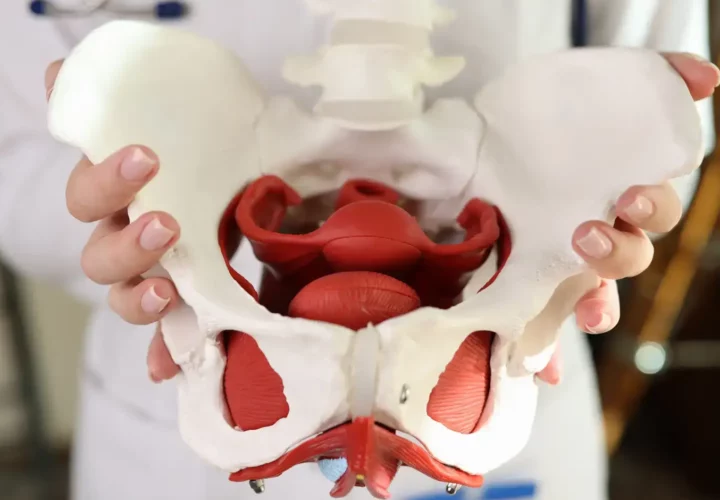KFS or Klippel-Feil Syndrome is a congenital bone condition where at least 2 vertebrae in the cervical spine are fused and immobile. In return this creates a shortened neck. Depending on the number of vertebra fused and location, pain can be very mild to highly severe. Also, many other abnormalities in the body can be associated with this. Though fewer than 50% of people with KFS have all 3 signs, most people have one of the three following signs:
- Visibly Short Neck
- Low hairline behind the head
- Reduced mobility in the neck
What to Know
KFS is present from birth and lasts the duration of that persons life. Some estimates predict every 1 in 40,000 people have KFS. However, KFS is not always noticed at birth or childhood. Actually, if the person has a mild case or it is accompanied by other conditions, decades may pass before KFS is diagnosed. However, as the body grows, more conditions can develop. Osteoarthritis has been known to develop around the fusions which leads to bone spurs.
Causes
Between the 3rd and 8th week of womb development, the spine begins to develop and divide. This is when Klippel-Feil Syndrome starts. Though the exact mechanisms of how this condition develops are still being studied, there are two ways it can occur; sporadic and genetics. Sporadic is the most common way and can occur without any family history or known genetic component. Genetic Mutation however can include many types which creates KFS.
Classifications
There are 3 types of classifications
- Type 1. This include extensive fusion of most or all the cervical spine.
- Type 2. Fusion or only 1-2 vertebrae found in the cervical spine.
- Type 3. Fusion exists in part of the thoracic/lumbar spine and includes either type 1 or type 2.
However, with more research being done in the recent years, different gene mutations have been taken into account when it comes to classification.
Signs and Symptoms
More common signs and symptoms include:
- A visibly shortened neck/low hairline behind the head.
- Because of one cervical disc not forming and atleast one pair of vertebrae not fully developing, the cervical spine may look shorter.
- Neck mobility will be reduced.
- Of course this depends on the location within the cervical spine and number of vertebrae used, but some cases involve a highly reduced ability of rotating the neck. If the fusion is higher such as C1 fused with C2, the neck will experience even less ROM.
- Headaches
- This can occur because of muscle spasms in the neck from inflamed nerves. Also, pain related to KFS can be felt in the head. The intensity of the heachaches can range from mild to severe and they can come and go. You may even feel the pain from your headache in the face, jaw, or ear.
- Cervical Radiculopathy
- Sometimes malformation or spine degeneration can cause a cervical nerve root to become inflamed. Symptoms of this include an electric like shock, a tingling sensation such as pins and needles, numbness/weakness radiating down into the shoulder, arm, and/or hand.
- Cervical Myelopathy
- A segment of the spinal cord can become compressed if malformation or spinal degeneration occurs. Symptoms include pain, tingling, numbness, and weakness anywhere in the lower-part of the body.
Treatment
Treating KFS includes a thorough medical evaluation checking for other conditions or abnormalities that may be present. If other conditions are present, some treatment options will not be available. When treating, it is common for specialists from a variety of fields to help. If multiple conditions are being treated, the specialists will have to work together in a plan that works for you and them.
Some self-care options that may help with neck pain and/or headaches include:
- Modifying Activity
- If some activities increase pain they need to be avoided or modified.
- Ice/Heat Therapy
- Using a cold pack can lower inflammation and pain. A heat-pack may help loosen tense muscles and help increase blood flow to the area. However, do not apply either heat or ice for more than 15 minutes.
- OTC Medicine
- Over the counter medications may help reduce pain and inflammation. However, always read the labels and take the correct amount. If you are even the slightest bit unsure, check with a physician.
- Trying a new pillow.
- Pillows can make a big difference in terms of neck pain either sleeping or waking up. Try different pillow sizes, shapes, and fluffiness. Some people have even found sleeping with no pillow is what is best for them.
Other treatment options are also worth trying. These include:
- Physical therapy
- A physical therapist can help design a strengthening program with stretches that fit your specific case. This program will be aimed to help with ROM, pain, and stiffness.
- Prescribed Pain Medication
- Prescription-strength muscle relaxants may help reduce some pain during any muscle spasms. However, this type of medication is only prescribed on a short term basis.
- Back brace/ Cervical collar
- Back braces may help prevent some spinal deformities from worsening as your body continues to grow.
- Injections
- If a cervical root is inflamed, an anti-inflammatory steroid solution or local anesthetic may be injected to help reduce inflammation.
- Radiofrequency Ablation
- This treatment uses needles to place a heat lesion on a facet joint’s sensory nerve to prevent it from sending out pain signals to your brain. This has proven to relieve pain for 6-18 months.
Lastly, surgery is an option. If surgery is done, it is to stabilize the cervical spine to correct a spinal deformity or to take pressure off the nerves/spinal cord.



